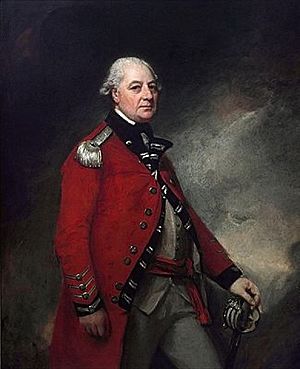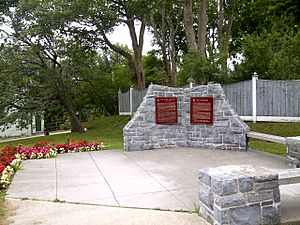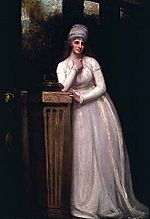George Townshend, 1st Marquess Townshend facts for kids
Quick facts for kids
The Marquess Townshend
|
|
|---|---|

Portrait by George Romney
|
|
| Born | 28 February 1724 London, England |
| Died | 14 September 1807 (aged 83) Raynham Hall, Norfolk |
| Allegiance | |
| Service/ |
|
| Years of service | 1743–1796 |
| Rank | Field Marshal |
| Battles/wars | War of the Austrian Succession Jacobite Rising Seven Years' War |
Field Marshal George Townshend, 1st Marquess Townshend (born February 28, 1724 – died September 14, 1807), was an important British soldier and politician. He was known as The Viscount Townshend for many years. He fought in major wars like the War of the Austrian Succession and the Seven Years' War.
Townshend took charge of British forces during the final part of the Battle of the Plains of Abraham in Canada. Later, he became the Lord Lieutenant of Ireland, which was like being the King's representative or governor there. In this role, he worked to make Irish army groups stronger and to improve Ireland's economy. He also served as the Master-General of the Ordnance, a top job in charge of military supplies.
Contents
Military Career and Early Life
Joining the Army
George Townshend was born in London, England. His father was Charles Townshend, 3rd Viscount Townshend. George went to school at Eton College and then St John's College, Cambridge.
He joined the army as a volunteer in 1743. His first battle was the Battle of Dettingen in June 1743. This was during the War of the Austrian Succession. He became a captain in the 7th Regiment of Dragoons in 1745.
Key Battles and Promotions
Townshend fought in the Battle of Culloden in April 1746. This battle was part of the Jacobite Rising. He also served as an aide-de-Camp (a personal assistant) to the Prince William, Duke of Cumberland. In 1747, he took part in the Battle of Lauffeld in Belgium.
While serving in Belgium, Townshend was also chosen to be a Member of Parliament for Norfolk. He became a lieutenant colonel in the army in 1748. He believed that army discipline should be handled by courts martial rather than just commanding officers. He also helped pass the Militia Act of 1757, which created a larger local defense force.
Seven Years' War in Canada
In 1759, Townshend was given command of a group of soldiers in Quebec, Canada. This was during the Seven Years' War. He served under General James Wolfe. On September 13, 1759, General Wolfe was killed during the Battle of the Plains of Abraham. The second-in-command was wounded. So, Townshend took over command of the British forces.
He received the surrender of Quebec City on September 18, 1759. After this important victory, he returned to Great Britain. He was promoted to major general in 1761. He also fought in the Battle of Villinghausen in July 1761. In 1762, he led a part of the British and Portuguese army to defend Portugal from a Spanish invasion.
Leading Ireland
Lord Lieutenant of Ireland

In 1767, George Townshend became the Lord Lieutenant of Ireland. This was a very important job, as he was the King's chief representative in Ireland. He wanted to make the Irish army stronger. He also aimed to reduce corruption and improve the Irish economy.
However, the Parliament of Ireland did not agree with some of his plans. This made him unpopular in Dublin. He worked closely with Prime Minister Lord North in London. Together, they worked to give the British government more control over Ireland.
Later Life and Achievements
Return to Office
Townshend was promoted to lieutenant general in 1770. He left his role as Lord Lieutenant of Ireland in 1772. He then returned to office as the Master-General of the Ordnance in October 1772. This role put him in charge of all military supplies and weapons.
In 1779, a fort in Newfoundland and Labrador was named Fort Townshend after him. He left the Master-General position in 1782. However, he was promoted to full general in 1782 and returned to the Master-General role in 1783. He finally retired from this office in 1784.
Final Years
On October 27, 1787, George Townshend was given the special title of Marquess Townshend. He became the Lord Lieutenant of Norfolk in 1792. He also served as Governor of Kingston-upon-Hull and the Royal Hospital Chelsea.
In 1796, he was promoted to field marshal, the highest rank in the British Army. George Townshend passed away at his family home, Raynham Hall in Norfolk, on September 14, 1807. He was buried there in the family burial place.
Family Life

George Townshend married Charlotte Compton in 1751. She was the 16th Baroness Ferrers of Chartley. They had eight children together:
- George Townshend, 2nd Marquess Townshend (1755–1811)
- Lord John Townshend (1757–1833)
- Lady Elizabeth Townshend (died 1811)
- The Rev. Lord Frederick Patrick Townshend (1767–1836)
- Lord Charles Townshend (1768–1796)
- Lady Charlotte (1757)
- Lady Caroline
- Lady Frances Townshend
After Charlotte passed away in 1770, he married Anne Montgomery in 1773. Anne was the daughter of Sir William Montgomery, 1st Baronet. They had six children:
- Lord William Townshend (1778–1794)
- Captain Lord James Nugent Boyle Bernardo Townshend (1785–1842)
- Lady Anne Townshend (1775–1826)
- Lady Charlotte Townshend (1776–1856)
- Lady Honoria Townshend (1777–1826)
- Lady Henrietta Townshend (died 1848)


